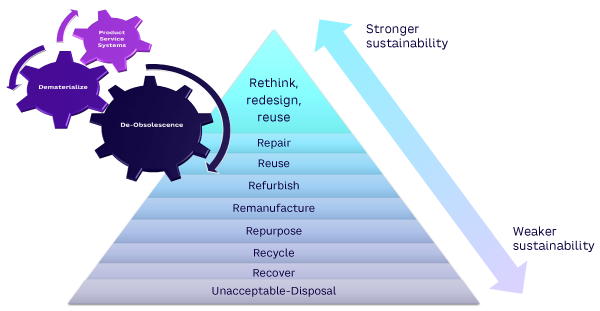AMPLIFY VOL. 1, NO. 5

The authors discuss how concepts like circular economy, degrowth, and post-growth redefine which materials are considered waste and which are considered useful. Circular economy and degrowth approaches could provide stronger sustainability outcomes by rethinking what counts as waste in supply chain analyses, operations, and management. The authors look at supply chain subsystems that support strong sustainability outcomes, using practical examples. They show how strong sustainability can support societal and economic resilience and identify ways to overcome challenges to changing market systems.
The pandemic threw into stark relief how quickly the world and its systems can change. What was once considered impossible — the shutdown of economic systems for the benefit of society as a whole — became possible. Governments, communities, businesses, and almost every other institution paused for an extended period. As systems have slowed, some of them (like supply chains) have become less resilient or been completely disrupted. In the midst of this chaos, we are learning a lot about transitions to sustainability.
As members of Future Earth’s Systems of Sustainable Consumption and Production Knowledge-Action Network (SSCP KAN), we conduct research that creates knowledge and catalyzes actions to support resilient, sustainable systems. The academic community at large has been debating the issues and contexts of sustainable consumption and production for a number of decades. The recent public health crisis elevated this discourse to a new level.
A working group within SSCP KAN has been studying (and unabashedly championing) the circular economy. In “The Circular Economy — A New Sustainability Paradigm?” Geissdoerfer et al. define the circular economy as a “regenerative system in which resource input and waste, emission, and energy leakage are minimized by slowing, closing, and narrowing material and energy loops.” The authors argue that a circular economy can be achieved through “long-lasting design, maintenance, repair, reuse, remanufacturing, refurbishing, and recycling.”1
The idea of the circular economy has been around for decades. Although a single definition has been elusive and assessment frameworks remain fuzzy, in the last five years, policy makers, industrial managers, and financiers have ramped up their interest and support for it.2 Proponents point to its potential to address several of the grand challenges facing society: contributing to the United Nations (UN) Sustainable Development Goals (SDGs), mitigating climate change, and reinvigorating our economic systems after the pandemic.
Critics have raised credible questions about whether the circular economy can result in strong sustainability, defined as a deep change resulting in “continuance in the long term,” where no future resource or social system is threatened by today’s actions.3 Another perspective to consider is that weak sustainability allows for the diminishment of natural systems if human systems benefit, while strong sustainability does not allow such a transfer.4
Some argue that degrowth and post-growth are more closely aligned to strong sustainability (degrowth is a drastic reduction in consumption and production as a way to improve human well-being). Many degrowth scholars argue that the circular economy is a way of depoliticizing growth such that it happens in an unsustainable fashion. They worry that organizations can use the language of circular economy without substantially changing their practices — in essence, greenwashing.5
In an earlier commentary, we argued that pitting circular economy against degrowth creates a false dichotomy.6 A recent editorial in Nature agrees with our assessment.7 In this article, we discuss how the two perspectives can be brought together, identifying the infimals (subsystems) that contribute to both supremals (the circular economy and degrowth) in the context of strong sustainability.
Specifically, we draw attention to infimals such as dematerialization, de-obsolescence, and product-service systems (PSS). Patterns, structures, and mental models associated with these systems require us to consider their implications on humanity’s well-being and other broad measures of social progress.
Circular Economy
Given this publication’s audience of information systems experts, we provide a series of industry examples that show the power of a circular economy system, and its shortcomings, from a sustainability perspective.
The evolution of the circular economy has been closely aligned with the sustainability of information systems (IS) or green information technology (IT). The IS and IT communities are necessary and integral players.8, 9 Advances in digitalization and circular economy are increasingly interconnected.
One of the most basic infimals of circularity is recycling. Materials from end-of-life of IT hardware can be acquired from disassembled computer hardware. Plastics, metals, and glass are part of every computer and computer infrastructure. A subsystem connecting actors on both the consumption and production sides is required to collect, deconstruct, store, and distribute these materials to realize the benefits.
Currently, this subsystem needs fresh inputs. Although recycling is at the forefront of most people’s minds when the concept of circular economy is raised, such procedures are actually close to the bottom of the circular hierarchy (see Figure 1). In some cases, recyclability can impose greater environmental impacts than using virgin materials. A social phenomenon called “wishcycling” (the well-intentioned belief that a product or material is recyclable when it is not) can also create problems.

As a rule of thumb, infimals of repurposing (using discarded parts in a new product with a different function) and remanufacturing (using discarded parts in a new product with the same function) offer higher levels of circularity, use fewer natural resources, retain more of the value and function of the original product, and impose less environmental pressure than recycling.10
Reusing and repairing typically promise even higher environmental gains, but even these subsystems can flatter to deceive. For example, reusing can do more harm than good, keeping inefficient products in circulation (e.g., cathode ray televisions and monitors) while their new, more efficient replacements add to the number of total products in use.
There is also a social response called the “rebound effect” within a putative circular economy system, where organizations and individuals increase the use of services or products because there is less inhibition and guilt. This creates a challenge for eco-efficiency-based solutions that lack supporting behavioral systems.
This is why subsystems based on rethinking and redesigning are needed. PSS (also known as servicization or servicizing) is a prime example. In IT, cloud computing is an important PSS. Software that was previously sold as a product with a package, manuals, and disks now resides on interorganizational networks. Software and data storage have become services rather than products. This example also represents dematerialization or ephemeralization in the IT industry as less material is being used, reducing resources at various stages of production and distribution. However, managing some aspects of production and service delivery may require additional resources and materials. For example, the network hardware, energy usage, and data warehousing storage facilities could cause even greater resource usage.
Another IT infimal is planned de-obsolescence: transformation in the design, manufacture, and returns of materials and products to extend the life of the product; for example, modular design for computers and supporting systems (modular design may mean simply updating various aspects of computers as innovations are introduced). Many times, the innovations are incremental and consist of either engineered or manufactured parts that can quickly be adapted.
Consideration of the challenges of current circular solutions brings us to another supremal of the sustainability discourse: the degrowth economy.
Degrowth Economy
Degrowth economists argue that we should focus on using drastically fewer resources and consuming less through new political-economic paradigms to achieve strong sustainability and improve human well-being.11
In a 1968 speech at the University of Kansas about the inadequacies of gross national product (GNP), Robert F. Kennedy once argued that it measured “everything, in short, except that which makes life worthwhile.”12 The degrowth school of thought has substantially extended this perspective, contributed to the era of ferment involving alternative measures of progress competing to replace GNP (now called GDP, or gross domestic product), and institutionalized a new socioeconomic system to support a range of new measures.
A good example is the Beyond GDP project,13 which has engaged global statisticians through the United Nations Statistical Commission. The institutionalization of a single Beyond GDP metric (or a dashboard approach of additional metrics to complement GDP) is seen as a way to lessen the dominance of customary economic growth concepts and rebalance political and economic systems toward social and environmental goals.14
There are several very practical infimals shared by the degrowth supremal and the circular economy supremal. For example, dematerialization contributes by requiring less material use to achieve similar levels of utility from products and services. Options exist to rethink and redesign products where less material is required or where certain problematic materials are replaced with less environmentally damaging alternatives. Including dematerialization in design and applying systems thinking has long been seen as a way of reducing the input of energy and materials, in some cases, by a factor of four or even a factor of 100.15 Dematerialization on this scale is aligned with the demands of degrowth, but there remains significant room for improvement.
Durability is another example. Some industries have made strides on product durability, but the electronic products industry is lagging. A 2021 study funded by the EU analyzed opportunities for more durable smartphones, pointing to the need to design products with more resilience to environmental stresses and improper use, better batteries, and future-proofing in terms of user needs (e.g., software/firmware updates and enhanced memory/storage capacity).16
Dematerialization, material substitution, and durability are examples of the more practical infimals supporting degrowth. These interventions can be coupled with the circular economy infimals of de-obsolescence and PSS to support strong sustainability goals.
Similar to the circular economy repair infimal, the democratization of technology supports degrowth. For example, products designed for repair can result in less consumption by extending the life. Community-run repair cafes are springing up in cities and towns to support this endeavor, especially for electrical products, which are often beyond the technical capabilities of end users to service.17, 18 The recently proposed US Fair Repair Act of 2022 and other pending bills to codify a right to repair support both higher degrees of circularity and degrowth transitions.
Bridging the Divide for Strong Sustainability
Production- and consumption-related infimals help change organizational and individual behavior around circular economy and degrowth systems. Eco-efficiency strategies for organizations include initiatives related to goods and services provisioning.19 Sustainable supply chain management includes eco-efficiency activities that can function within a circular system, ranging from end-of-pipe capture solutions to cleaner production activities. Designing for the environment is another opportunity to “green” products at early stages.
The consumption side also has links to the circular economy and degrowth. These activities could be defined as sufficiency strategies; they include expenditure mix and realization of quality of life.20 These activities shift consumption from material to immaterial (dematerialized or PSS infimals) without causing undue societal disruption or unjust social results.
The final element of a sufficiency strategy is to try to improve well-being with the same or lessened per unit expenditure. For example, the advent of streamed movies means we can see the latest films without traveling to a theater; although the social experience may be lost, other gains can occur.21
Bundling services can also change behavior and enhance well-being without conventional economic growth. For example, in Switzerland, travelers can buy the mobility option that best suits their needs. Mobility services are integrated into a digital platform and a user app, providing door-to-door transport and offering individualized trip-planning and payment options. Users can buy a single ticket or a monthly subscription.22 Note that the underlying regional partnership requires support from consumers, platform developers, service providers, communities, and regulators and that these types of innovations require new technologies, enhanced integration, and behavior change.
The roster of infimals is changing and growing, giving rise to significant challenges for managers and organizations. But there is an argument for potentially positive consequences in the long run, one of which is resilience.
Circular Economy + Degrowth = Strong Sustainability -> Resilience
The pandemic showed us the need to build sustainability and resilience into our systems. Stories about electronic equipment such as ventilators needing local parts were widely circulated at the height of the pandemic. Indeed, we saw that circular economy practices resulted in greater resilience by strengthening localization of sourcing and building agility.23 However, we must realize that resilience may also depend on redundancy and having reliable and multiple circular sources.
For a time, economic growth was less of a concern as resilience assumed greater importance. Shifting away from growthism and focusing on sufficiency was elemental to building an enhanced capacity for resilience.
Resilience is, of course, a critical feature of strong sustainability. As we became less arrogant and insistent about economic growth, the pandemic experience showed us how resilience can be built into our responses to sustainability crises like climate change.24
We now turn to identifying actions that can help us address these challenges.
Overcoming Challenges
Both circular economy and degrowth can help us overcome challenges through coordination at the supremal and infimal levels. Instead of a growth spiral (where a circular economy results in unsustainable growth), we must coordinate both to be part of a degrowth spiral. The technology-organization-environment framework can help determined enablers assist in resolving tensions.
General-purpose technologies can make processing more efficient and enable resource sharing in PSSs. Integrated, multi-stakeholder technologies such as the Internet of Things, blockchain technology, artificial intelligence, and global positioning systems are examples of information technologies that can move production-consumption systems toward strong sustainability. The same is true for biotechnologies and self-repairing nano technologies that can contribute to the development of new materials consistent with the objectives of dematerialization and de-obsolescence.
Opportunities for organizational innovation include new methods for contractual relationships. For example, leasing rather than owning is a way to maintain product- and material-stewardship control.25 Similar innovations will be needed to support product and material recovery in order to encourage circular and degrowth design and production and create value from use optimization.
There is a business case for using circularity and degrowth simultaneously. For example, Bosch Power Tools produces high-quality, durable work equipment. It is able to build for de-obsolescence by upgrading its power drills using remanufacturing principles. This uses less virgin material while allowing the company to effectively compete against poorer-quality, lower-priced alternatives.
Managing in this circular environment with degrowth is not a trivial decision, and each business case will vary based on products, ability to process materials, and access to end-of-life products.26
Governments must design innovative policies that change the rules of the game and create markets that favor organizations and end users embracing circularity and degrowth and letting them showcase their successes in public forums. Equity is (or should be) a concern for policy makers. No one should be left behind as these systems initiatives are applied — a key element in the EU’s circularity-friendly Green Deal initiative.
This transition will require alternative skills and jobs. New work models will be needed, not only for circular economy and degrowth systems, but for work environments such as Industry 4.0 to support closer alignment with the principles of strong sustainability.
Transdisciplinary Opportunities
We must create opportunities for organizations and individuals to work across sectors and disciplines — a transdisciplinary effort. For example, industrial, governmental, academic, and nongovernmental organizations (NGOs) have jointly tried to develop a roadmap for the circularity of electronics through the Circular Electronics Partnership (CEP).27 CEP involves multiple stakeholders and provides a series of action items designed to catalyze and nurture the necessary changes. The roadmap provides an overall vision for a circular economy as well as specific strategic steps and practices.
Researchers are increasingly focused on the concept of co-creation, which emphasizes close, long-term relationships between academics and industrial and societal stakeholders. Co-creation recognizes that scholarship is only one input into complex processes of adaptation. At the same time, industrial solutions singularly oriented around profits can cause serious unforeseen consequences to broader society. Collaborative efforts between scholars and non-academic stakeholders can increase legitimacy, ownership, and accountability for both the problem and the solution.28
Both our circular economy working group and SSPC KAN actively encourage transdisciplinary co-creation and co-action.29 We are writing this article to encourage members of the broader community to join us. We recognize that industry, government, and local communities must join with scholars, think tanks, and NGOs to lead this effort. Consider this an open invitation for readers to join us in understanding, building, implementing, and maintaining strong, sustainable systems.
References
1Geissdoerfer, Martin, et al. “The Circular Economy — A New Sustainability Paradigm?” Journal of Cleaner Production, Vol. 143, No. 1, February 2017.
2Dewick, Paul, et al. “Circular Economy Finance: Clear Winner or Risky Proposition?” Journal of Industrial Ecology, Vol. 24, No. 6, December 2020.
3For the debates between “weak” and “strong” sustainable consumption, see: Lorek, Sylvia, and Doris Fuchs. “Strong Sustainable Consumption Governance: Precondition for a Degrowth Path?” Journal of Cleaner Production, Vol. 38, January 2013.
4Solow, R.M. “Intergenerational Equity and Exhaustible Resources.” The Review of Economic Studies, Vol. 41, 1974.
5Valenzuela, Francisco, and Steffen Böhm. “Against Wasted Politics: A Critique of the Circular Economy.” Ephemera: Theory & Politics in Organization, Vol. 17, No. 1, 2017.
6Schröder, Patrick, et al. “Degrowth Within — Aligning Circular Economy and Strong Sustainability Narratives.” Resources, Conservation & Recycling, Vol. 146, July 2019.
7“Are There Limits to Economic Growth? It’s Time to Call Time on a 50-year Argument.” Nature, 16 March 2022.
8Sarkis, Joseph, and Hanmin Zhu. “Information Technology and Systems in China’s Circular Economy.” Journal of Systems and Information Technology, Vol. 10, No. 3, November 2008.
9Sarkis, Joseph, Chulmo Koo, and Richard T. Watson. “Green Information Systems & Technologies — This Generation and Beyond: Introduction to the Special Issue.” Information Systems Frontiers, Vol. 15, October 2013.
10Potting, José, et al. “Circular Economy: Measuring Innovation in the Product Chain.” PBL Netherlands Environmental Assessment Agency, January 2017.
11Kallis, Giorgos, et al. “Research on Degrowth.” Annual Review of Environment and Resources, Vol. 43, October 2018.
12Kennedy, Robert F. “Remarks at the University of Kansas, March 18, 1968.” John F. Kennedy Presidential Library and Museum, accessed May 2022.
13“Beyond GDP: Making Nature Count in the Shift to Sustainability.” United Nations Environment Programme (UNEP), accessed May 2022.
14van den Bergh, Jeroen C.J.M. “A Procedure for Globally Institutionalizing a ‘Beyond-GDP’ Metric.” Ecological Economics, Vol. 192, February 2022.
15Hawken, Paul, Hunter Lovins, and Amory Lovins. Natural Capitalism: Creating the Next Industrial Revolution. Little, Brown & Company, 1999.
16Cordella, Mauro, et al. “Durability of Smartphones: A Technical Analysis of Reliability and Repairability Aspects.” Journal of Cleaner Production, Vol. 286, March 2021.
17van der Velden, Maja. “‘Fixing the World One Thing at a Time’: Community Repair and a Sustainable Circular Economy.” Journal of Cleaner Production, Vol. 304, July 2021.
18Moalem, Rikke Marie, and Mette Alberg Mosgaard. “A Critical Review of the Role of Repair Cafés in a Sustainable Circular Transition.” Sustainability, Vol. 13, No. 22, November 2021.
19Tukker, Arnold, et al. “The Impacts of Household Consumption and Options for Change.” Journal of Industrial Ecology, Vol. 14, No. 1, January/February 2010.
20Bocken, Nancy M.P., and Samuel W. Short. “Towards a Sufficiency-Driven Business Model: Experiences and Opportunities.” Environmental Innovation and Societal Transitions, Vol. 18, March 2016.
21Jungall-Michelsson, Jessica, and Pasi Heikkurinen. “Sufficiency: A Systematic Literature Review.” Ecological Economics, Vol. 195, May 2022.
22Jittrapirom, Peraphan, et al. “Mobility as a Service: A Critical Review of Definitions, Assessments of Schemes, and Key Challenges.” Urban Planning, Vol. 2, No. 2, June 2017.
23Nandi, Santosh, et al. “Redesigning Supply Chains Using Blockchain-Enabled Circular Economy and COVID-19 Experiences.” Sustainable Production and Consumption, Vol. 27, July 2021.
24Sarkis, Joseph, et al. “Overcoming the Arrogance of Ignorance: Supply-Chain Lessons from COVID-19 for Climate Shocks.” One Earth, Vol. 3, No. 1, July 2020.
25Stahel, Walter R. “The Circular Economy.” Nature, Vol. 531, March 2016.
26Atusu, Atalay, Céline Dumas, and Luk N. Van Wassenhove. “The Circular Business Model.” Harvard Business Review, July–August 2021.
27“Circular Electronics Roadmap: An Industry Strategy Towards Circularity.” Circular Electronics Partnership (CEP), accessed May 2022.
28Mauser, Wolfram, et al. “Transdisciplinary Global Change Research: The Co-Creation of Knowledge for Sustainability.” Current Opinion in Environmental Sustainability, Vol. 5, No. 3-4, September 2013.
29Hofstetter, Joerg S., et al. “From Sustainable Global Value Chains to Circular Economy — Different Silos, Different Perspectives, but Many Opportunities to Build Bridges.” Circular Economy and Sustainability, Vol. 1, March 2021.







